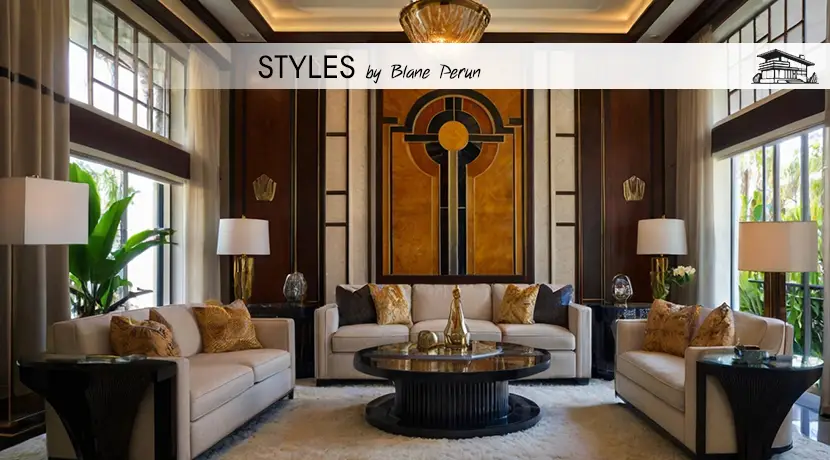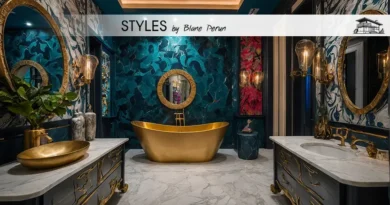Art Deco Style
Embracing Elegance: The Charm of Art Deco Interior Design
Art Deco Interior Design, a visual and influential arts design style which first appeared in France just before World War I, has an undeniable charm that continues to captivate enthusiasts worldwide. With its distinctive blend of geometric shapes, rich colors, and luxurious materials, this design style brings a touch of opulence and sophistication to any space. It’s a style that doesn’t just whisper elegance; it shouts it, making any room stand out with its bold patterns and intricate detailing. This article will dive into the essence of Art Deco, exploring its key elements, historical roots, and how it can be seamlessly integrated into modern interiors.

The Historical Essence of Art Deco
The Birth and Evolution of Art Deco
Art Deco, short for Arts Décoratifs, is more than just a design style; it’s a historical movement that mirrored the rapid technological advancements and cultural shifts of the early 20th century. Originating in the 1920s and 1930s, this style was a response to the desire for a new aesthetic that broke away from the past, embracing instead the possibilities of the future. It’s characterized by the use of symmetrical designs, stylized motifs, and the incorporation of materials like stainless steel, aluminum, and inlaid wood.
Iconic Art Deco Architecture and Interiors
When we talk about Art Deco, it’s impossible not to mention the iconic buildings and interiors that have become synonymous with this style. Structures like the Chrysler Building in New York City or the Palais de Chaillot in Paris are not just architectural feats; they are beacons of Art Deco design, showcasing the style’s penchant for vertical lines, geometric patterns, and the integration of art into architecture. These landmarks serve as a testament to the enduring appeal of Art Deco and its ability to transcend time.
Key Elements of Art Deco Interior Design
Geometric Patterns and Bold Lines
One of the most recognizable aspects of Art Deco Interior Design is its use of bold geometric patterns and lines. Think zigzags, chevrons, and sunburst motifs that capture the dynamic energy of the era. These patterns are not just decorative; they are symbolic of the machine-age optimism and the societal shift towards modernity. Incorporating these designs into wallpaper, flooring, or textile patterns can instantly infuse a space with the Art Deco spirit.
Luxurious Materials and Glamorous Finishes
Art Deco is synonymous with luxury and glamour, often utilizing materials that exude opulence. From polished wood and lacquer to velvet and silk, the textures in Art Deco interiors are all about indulgence. Metals like chrome and brass are also staples in Art Deco design, used in everything from lighting fixtures to furniture, adding that signature sparkle and shine that the style is known for.
Modern Interpretations of Art Deco
Art Deco in Contemporary Spaces
While Art Deco has its roots in the early 20th century, its influence is still felt in contemporary interior design. Modern interpretations often mix Art Deco elements with minimalist or other design styles to create spaces that are both nostalgic and forward-looking. By incorporating Art Deco furniture pieces or accessories, designers can add a layer of sophistication and timelessness to even the most modern spaces.
Technology and Art Deco: A Synergistic Relationship
In today’s digital age, technology has opened up new avenues for exploring and integrating Art Deco designs into interiors. Digital printing technologies, for example, allow for the replication of complex Art Deco patterns on wallpapers and fabrics, making the style more accessible. Additionally, 3D modeling and rendering have enabled designers to experiment with Art Deco elements in virtual spaces, pushing the boundaries of how this historical style can be adapted for the 21st century.
Art Deco Interior Design is more than just a trend; it’s a testament to the human spirit’s endless pursuit of beauty and innovation. From its geometric patterns and luxurious materials to its ability to adapt and evolve with the times, Art Deco offers a rich palette for anyone looking to infuse their space with elegance and sophistication. Whether you’re a seasoned interior designer or a homeowner with an appreciation for historical styles, Art Deco offers endless inspiration for creating spaces that are both timeless and contemporary.

FAQs:
What defines Art Deco Interior Design? Art Deco Interior Design is characterized by its emphasis on geometric shapes, bold lines, and luxurious materials. It combines modernist styles with fine craftsmanship and rich materials. This design style is known for its use of metallic finishes, vibrant colors, and symmetrical patterns, all of which contribute to its timeless elegance and sophistication.
How can I incorporate Art Deco elements into a modern home? Incorporating Art Deco elements into a modern home can be as simple as adding Art Deco-inspired furniture pieces, lighting fixtures, or accessories. Look for items with geometric patterns, metallic finishes, and bold, symmetrical designs. Wallpaper with Art Deco patterns or even incorporating velvet and silk textiles into your decor can add a touch of the style. Mixing these elements with modern design principles can create a harmonious and updated interpretation of Art Deco.
Why is Art Deco considered timeless? Art Deco is considered timeless because of its unique blend of sophistication, elegance, and modernity. Its bold geometric patterns, luxurious materials, and emphasis on craftsmanship appeal to a wide range of tastes and can complement various architectural styles. Additionally, its ability to evolve and adapt to contemporary trends keeps it relevant and admired across generations.
Can Art Deco design be budget-friendly? Yes, Art Deco design can be adapted to suit a range of budgets. While original Art Deco pieces may be costly, there are many ways to achieve the look without breaking the bank. Affordable replicas, DIY projects, and selective incorporation of Art Deco motifs through smaller decor items or textiles can give your space a touch of the style without a significant investment.
How does Art Deco differ from other design styles? Art Deco is distinct in its use of geometric shapes, symmetrical patterns, and a combination of luxury and industrial materials. Unlike styles that emphasize organic forms or rustic finishes, Art Deco is known for its sleek lines, metallic accents, and a general sense of opulence and glamor. It stands out for its bold approach to design and its ability to seamlessly blend art with functional design elements.
In conclusion, Art Deco Interior Design continues to enchant and inspire with its unique blend of historical elegance and modern flair. Its rich history, distinctive aesthetic, and adaptability to contemporary tastes make it a beloved style among designers and homeowners alike. Whether you’re looking to add a touch of glamour to your living space or fully embrace the Art Deco ethos, this design style offers endless possibilities to create interiors that are both striking and timeless.





